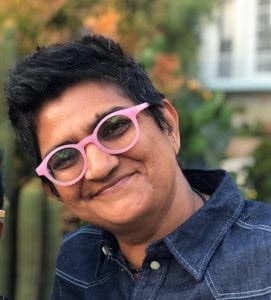 Dr. Anjali Arondekar, associate professor of feminist studies and co-director of the Center for South Asian Studies at the University of California, Santa CruzNani Sahra Walker
Dr. Anjali Arondekar, associate professor of feminist studies and co-director of the Center for South Asian Studies at the University of California, Santa CruzNani Sahra Walker
“The first thing to note is caste discrimination is not a new thing in the U.S. nor in South Asia,” said Dr. Anjali Arondekar, an associate professor of feminist studies and co-director of the Center for South Asian Studies at the University of California, Santa Cruz (UCSC). “It’s a structural form of labor segmentation that is passed down over generations.”
Arondekar, a scholar from a caste-oppressed community among the South Asian diaspora, said Dalit and Bahujan are the preferred terms of many in that community. Throughout her higher education career in the U.S. for about 35 years, Arondekar said she, like many, has experienced caste-based discrimination without fully having the language for it to be recognized on campus.
“But the primary energy of these movements to acknowledge caste on campus is coming from students,” she noted. “I think the gathering of youth becoming more involved, particularly in California, has created the perfect blend of activism and structural change at this moment.”
She explained, however, that some critics argue calling out caste can be Hindu-phobic or narrowly focused on India. Yet Arondekar pointed out that caste-based discrimination is geopolitically and religiously diverse. There are Dalit Muslims and Dalit Christians, as well as Dalit people from Nepal and Sri Lanka, not only India.
Prem Pariyar, the CSU graduate and activist who led CSU’s push to acknowledge caste, is a Dalit from Nepal who came to the U.S. for his degree, for instance. He has spoken often publicly about his experiences with caste-based discrimination in the Bay Area and as a CSU student. Diverse reached out to Pariyar for comment, though he was not available in time.
“We pride ourselves at CSU on the idea of inclusive excellence,” said Michael Uhlenkamp, senior director of public affairs at CSU. “Including caste parenthetically in our policy reflects the aspirations that we hold as a university in our commitment to inclusivity and respect.”
Uhlenkamp noted that the previous version of CSU’s anti-discrimination policy was believed to protect people from caste-based discrimination. But the new policy aims to make this clearer to community members by specifically naming caste.
Dr. Sarah Taylor, professor and chair of the department of social work at CSU East Bay, worked with Pariyar, a student in her department. She listened to Pariyar advocating to include caste to the department’s mission statement as a form of oppression and inequality that the department seeks to address.
“It was incredibly personal to us that one of our students brought this to our attention and taught us that caste discrimination is not something happening far away but in our own backyard in California,” said Taylor. “That was hard to ignore. So, we unanimously voted in our department to add caste.”
Pariyar’s activism later took him to the larger CSU system.
In the fall of 2021, the University of California, Davis (UC Davis) also recognized caste in their policy after community members, particularly students, shared their experiences. Brandeis University and Colby College have taken similar steps, as well as Harvard University’s graduate student union.
Danésha Nichols, director of UC Davis’s harassment & discrimination assistance and prevention program, shared advice for other higher education leaders considering recognizing caste-based discrimination on campus.
“The best place to start is at a place of exploration and education for yourself to try to wrap your mind around this experience,” said Nichols. “There are experts in this field who have had a lot more experience than I or my unit had in what caste-based discrimination looks like. Start from that place of curiosity—and listen.”
Arondekar added that she sees campuses acknowledging caste discrimination as part of larger movements to create equitable, inclusive spaces in higher education.
“While this focus on caste discrimination directly affects the South Asian diaspora, it is emblematic of our continued pursuit of a more robust vision of diversity in our society,” said Arondekar. “This aids and does not detract from the ways in which we are continually trying to think about how bias is structured in the workplace and needs to be constantly reimagined.”
Rebecca Kelliher can be reached at [email protected].






















